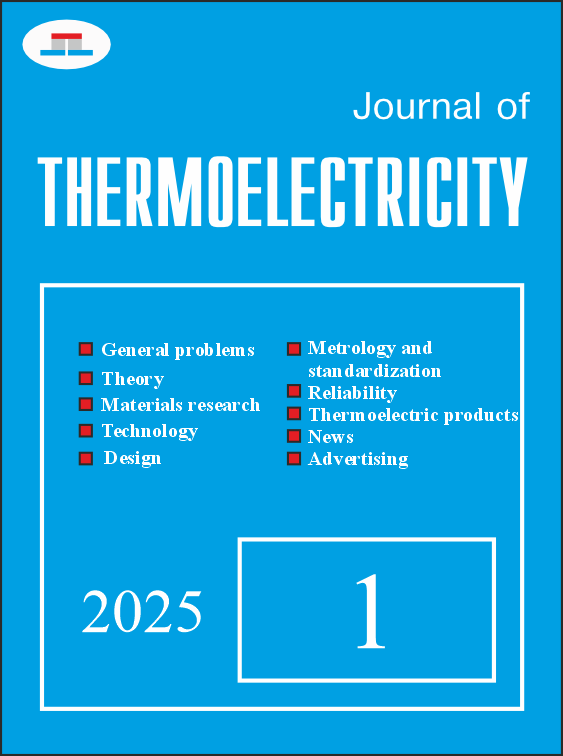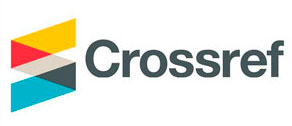Computer Simulation of the Vertical Zone Melting Method for Manufacturing Ingots of Bismuth-Telluride-Based Thermoelectric Materials with a Square Cross-Section
DOI:
https://doi.org/10.63527/1607-8829-2025-1-48-59Keywords:
simulation, vertical zone melting, thermoelectric material, bismuth tellurideAbstract
It has been shown that the losses of thermoelectric material when cutting disks with a circular cross-section into branches for thermoelements are significant – the weight of defective legs can reach 20–30%, depending on the sizes of the legs and disks. This can be avoided by manufacturing thermoelectric material in the form of ingots with a square cross-section. The results of computer simulation of vertical zone melting for producing square cross-section ingots of bismuth-telluride-based thermoelectric materials are presented. The dependence of the shape of the crystallization front on the geometric dimensions of the heater and coolers, their temperatures, movement speed, and other technological parameters is given. These dependencies have been analyzed for different materials used in the manufacture of the container in which the material is grown – quartz, ceramics, and graphite. A multifactor computer optimization of process parameters and equipment design has been conducted. Bibl. 26, Figs. 9.
References
1. Rowe, D. M. (Ed.). (2012). Modules, systems, and applications in thermoelectrics (1st ed.). CRC Press. https://doi.org/10.1201/b11892
2. d’Angelo M, Galassi C, Lecis N. Thermoelectric Materials and Applications: A Review. Energies. 2023; 16(17):6409. https://doi.org/10.3390/en16176409
3. Lon E. Bell. Cooling, Heating, Generating Power, and Recovering Waste Heat with Thermoelectric Systems. Science, 321, 1457-1461 (2008). DOI:10.1126/science.1158899
4. Riffat, S. B., & Ma, X. (2003). Thermoelectrics: A review of present and potential applications. Applied Thermal Engineering, 23 (8), 913-935. https://doi.org/10.1016/S1359-4311(03)00012-7
5. Jaziri, N., Boughamoura, A., Müller, J., Mezghani, B., Tounsi, F., & Ismail, M. (2020). A comprehensive review of thermoelectric generators: Technologies and common applications. Energy Reports, 6 (Suppl. 7), 264-287. https://doi.org/10.1016/j.egyr.2019.12.011
6. Anatychuk, L.I., & Kuz, R.V. (2016). Thermoelectric generator for trucks. Journal of Thermoelectricity, 2016(3), 40–45
7. Huang, L., Zheng, Y., Xing, L., & Hou, B. (2023). Recent progress of thermoelectric applications for cooling/heating, power generation, heat flux sensor and potential prospect of their integrated applications. Thermal Science and Engineering Progress, 45, 102064. https://doi.org/10.1016/j.tsep.2023.102064
8. Anatychuk, L., Lysko, V., & Prybyla, A. (2022). Rational areas of using thermoelectric heat recuperators. Journal of Thermoelectricity, (3-4), 43–67. https://doi.org/10.63527/1607-8829-2022-3-4-43-67
9. Kobylianskyi, R., Przystupa, K., Lysko, V., Majewski, J., Vikhor, L., Boichuk, V., Zadorozhnyy, O., Kochan, O., Umanets, M., & Pasyechnikova, N. (2025). Thermoelectric Measuring Equipment for Perioperative Monitoring of Temperature and Heat Flux Density of the Human Eye in Vitreoretinal Surgery. Sensors, 25(4), 999. https://doi.org/10.3390/s25040999
10. Anatychuk, L.I., & Kuz', R.V. (2015). Thermodynamic characteristic of cogeneration installations with thermoelectric heat recuperator. Materials Today: Proceedings, 2 (2), 871–876. https://doi.org/10.1016/j.matpr.2015.05.113
11. Meticulous Research. Thermoelectric modules market. Retrieved February 10, 2025, from https://www.meticulousresearch.com/product/thermoelectric-modules-market-5494.
12. Tritt, T. (2000). Recent trends in thermoelectric materials research, part two (Semiconductors and Semimetals, Volume 70). Academic Press. ISBN-13: 978-0127521794
13. H.J. Goldsmid. Bismuth Telluride and Its Alloys as Materials for Thermoelectric Generation. Materials. 2014. 7. P. 2577-2592. https://doi.org/10.3390/ma7042577
14. T. Cao, X.L. Shi, M. Li, B. Hu, W. Chen, W.Di Liu, W. Lyu, J. MacLeod, Z.G. Chen Advances in bismuth-telluride-based thermoelectric devices: progress and challenges. EScience. 2023. Vol. 3. Issue 3. Article 100122. https://doi.org/0.1016/j.esci.2023.100122
15. d’Angelo M, Galassi C, Lecis N. Thermoelectric Materials and Applications: A Review. Energies. 2023; 16(17):6409. https://doi.org/10.3390/en16176409.
16. Zhai, RS., Zhu, TJ. Improved thermoelectric properties of zone-melted p-type bismuth-telluride-based alloys for power generation. Rare Metals, 41, 1490–1495 (2022). https://doi.org/10.1007/s12598-021-01901-2
17. Nitsovich, O. V. (2018). Research on the conditions of forming a flat crystallization front when growing Bi₂Te₃-based thermoelectric material by vertical zone melting method. Journal of Thermoelectricity, (3), 76–82.
18. Anatychuk, L. I., & Nitsovich, O. V. (2018). Simulation of the effect of thermal unit velocity on the process of growing Bi₂Te₃-based materials by vertical zone melting method. Journal of Thermoelectricity, (3), 76–82.
19. Nitsovich, O. V. (2018). Computer simulation of Bi₂Te₃ crystallization process in the presence of electrical current. Journal of Thermoelectricity, (5), 12–21.
20. Lysko, V., & Nitsovich, O. (2023). Computer simulation of the process of manufacturing flat ingots of thermoelectric materials based on Bі2Tе3 by vertical zone melting method. Journal of Thermoelectricity, (3), 19–26. https://doi.org/10.63527/1607-8829-2023-3-19-26
21. Lysko, V., & Nitsovich, O. (2023). Computer optimization of the vertical zone melting method for manufacturing flat ingots of thermoelectric materials based on Ві2Те3. Journal of Thermoelectricity, (4), 27–37. https://doi.org/10.63527/1607-8829-2023-4-27-37
22. Anatychuk, L.I., & Lysko, V.V. (2012). Modified Harman's method. AIP Conference Proceedings, 1449, 373–376. https://doi.org/10.1063/1.4731574
23. Anatychuk, L.I., Havryliuk, M.V., & Lysko, V.V. (2015). Absolute method for measuring thermoelectric properties of materials. Materials Today: Proceedings, 2(2), 737–743. https://doi.org/10.1016/j.matpr.2015.05.110
24. COMSOL Multiphysics, v. 6.0. www.comsol.com. COMSOL AB, Stockholm, Sweden. 2021.
25. J. N. Reddy (2005). An Introduction to the Finite Element Method. 3rd Edition (McGraw-Hill Mechanical Engineering). 784 p.
26. Autorenkollektiv. (1983). Kristallisation aus Schmelzen: Eisenmetalle, Buntmetalle, Hochschmelzende Metalle, Halbleiterelemente, Edelmetalle, Radioaktive Elemente (K. Hein & E. Buhrig, Hrsg.). VEB Deutscher Verlag für Grundstoffindustrie.




